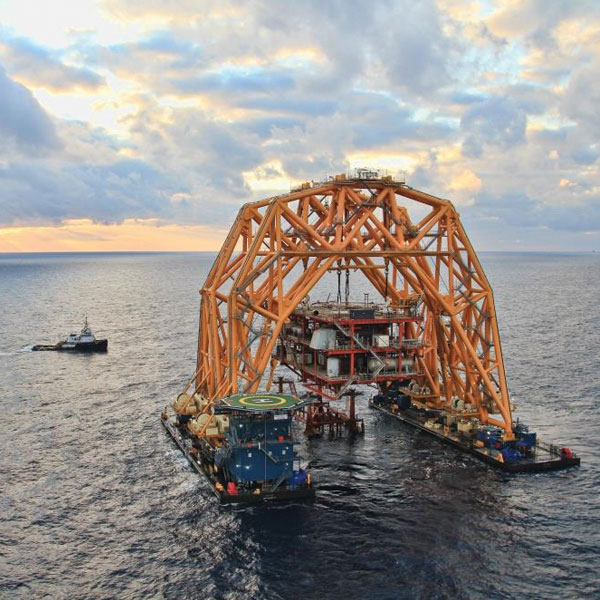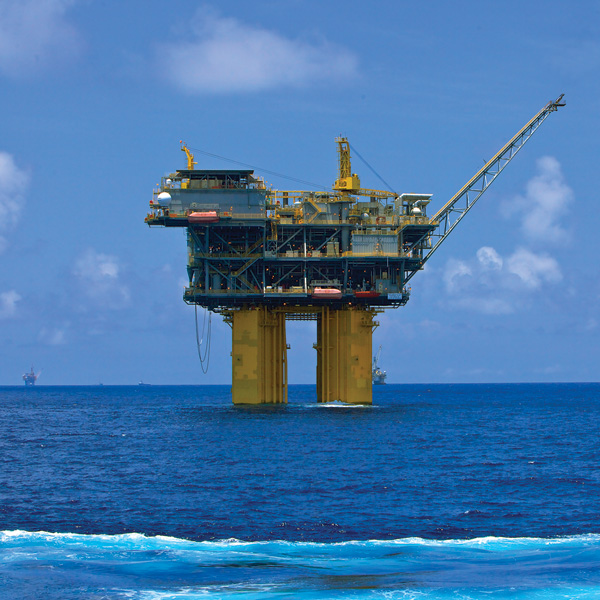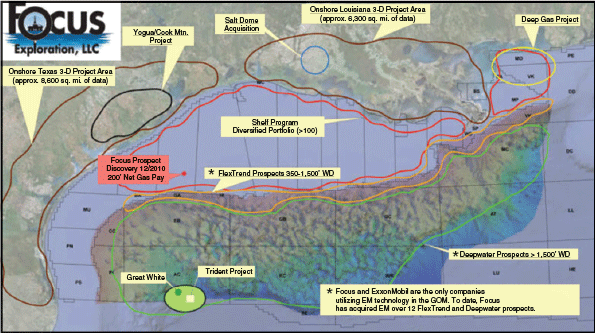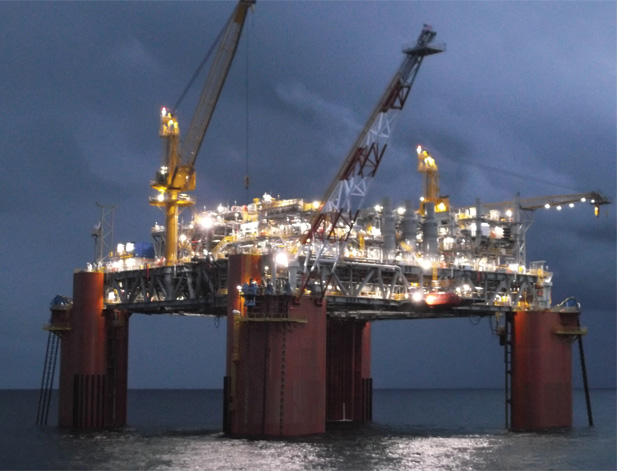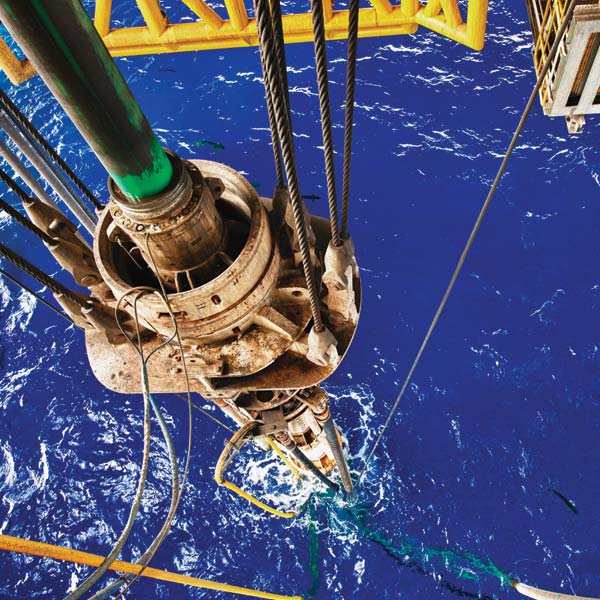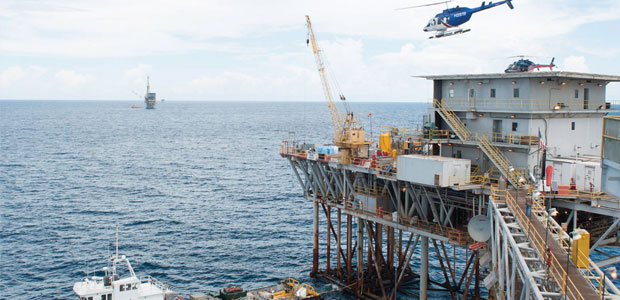
Gulf of Mexico Update
Gulf Operators Turn Eyes Toward Multiple Plays In Deep & Shallow Waters
By Danny Boyd, Special Correspondent
While onshore activity retains its share of headlines, independent oil and gas companies of all sizes continue to make waves in the Gulf of Mexico. Independents are capitalizing on a variety of opportunities that abound in one of the world’s most prolific offshore provinces. In deep water, operators are scoring big with discoveries of thick pays and massive reserves in the inboard Lower Tertiary and Lower Miocene, but the Gulf’s shallower-water regions also are enjoying a drilling and production renaissance.
New ventures on the Shelf are targeting Upper and Middle Miocene reserves, with the goal of tapping into economic reserves in pay thicknesses similar to those in the Lower Miocene play in deepwater blocks farther offshore. Shelf veterans also continue to exploit known reserves across the Gulf’s producing areas, while their deepwater counterparts focus their drill bits on massive oil reserves beneath salt in the basin’s deepest reaches. A few independents already are looking westward–to Mexican deep waters–as Mexico institutes economic reforms designed to pry open new areas for exploration.
Arena Energy is one Shelf player that continues to build its reserves through the drill bit, says Managing Director Michael Minarovic.
Although a privately held company, Arena is one of the top three most active drillers in the Gulf. The company, formed in 1999 as a self-described “pure Gulf of Mexico startup,” is spending $400 million-$500 million this year to drill and equip about 30 Shelf wells, according to Minarovic. All of the 2014 drilling prospects are in low-risk exploitation plays near existing production, and he adds that a similar drilling program is being planned for next year.
“We are Shelf players. That is who we are,” Minarovic says. “Everybody at Arena Energy developed their careers finding oil and gas in Shelf fields. We know that side of the Gulf business really well, and we are going to play it out. We are an exploitation, drilling-focused company. We take advantage of the lower-risk opportunities other people either do not see or choose not to pursue.”
The strategy has worked well for Arena Energy, based in The Woodlands, Tx. The company has a five-year drilling inventory, with a success rate in excess of 90 percent on more than 200 wells drilled during its 15-year history, he points out. Daily production is more than 20,000 barrels of oil equivalent.
Arena Energy will spend more than $400 million on its Gulf projects in 2014, including continuing development of the Riker area. By the end of 2013, the company had drilled and completed eight wells off the platform it installed in 2012. Arena says it plans to drill wells from the platform’s remaining 12 slots.
The majority of Arena’s exploitation drilling prospects has been identified through detailed technical field studies utilizing advanced geophysical and petrophysical tools, Minarovic says. As a result, the company’s oil and gas reserve base has been created primarily through drilling rather than acquiring production.
“Our success goes back to our basic belief when the company was founded that producing areas on the Shelf still held vast potential, and that with the right technology, talented oil and gas finders could unlock these drilling opportunities,” he remarks. “Today, that vision has been realized many times over.”
Success begets growth, and Minarovic points out that over the past six years, the size of Arena’s staff has doubled. It now owns and operates more than 70 Shelf platforms, and its total capital investment totals in excess of $2.4 billion with no outside equity sources.
A prime example of Arena’s strategy is its first discovery well, which was drilled in High Island six months after startup. Arena generated the prospect based on 3-D seismic analysis, and it was operated by partner Hall-Houston. The discovery well ultimately yielded 13 billion cubic feet of natural gas, Minarovic notes. The project involved leveraging technology to identify undrilled prospects near infrastructure in a producing area and working with an industry partner to get it drilled–the basic template of Arena’s strategy today, he says.
Minarovic points out current examples of projects are abundant–from Arena’s ongoing development drilling program at Eugene Island 314 to drilling operations that commenced earlier this year as part of ST Deep, a joint venture with Chevron on three giant legacy Shelf oil fields. Another case is the High Island A547 No. 6 wildcat, an amplitude-supported structure drilled late last year to a true vertical depth of 15,198 feet. The well encountered 140 feet of net pay in the Glob Alt section. Minarovic reports that Arena now is building and installing a platform, and the company plans to commence production in early 2015.
“Today, we are seeing some of the best opportunities on the Shelf since we started the company,” he concludes. “In fact, over the past five years, we have greatly expanded our Shelf drilling activity. We had to make a significant commitment to increase the size of our company to handle the opportunities as well as all the regulatory changes, but we are well positioned moving forward. Our inventory of prospects alone will keep us busy drilling wells for the foreseeable future.”
Miocene Prospects
While Miocene discoveries in the deepwater Gulf grab headlines, GulfSlope Energy Inc. is optimistic about Miocene prospects on the Shelf, where exploration in the play began, says Vice President Brady Rodgers.
Formed in 2013 by several Gulf of Mexico exploration and development veterans, GulfSlope submitted 22 high bids, totaling $7.8 million, on 22 blocks in the Central Gulf lease sale in March. The bids are part of the company’s 98,000-acre position that includes 17 prospects on the Outer Shelf and upper slope in water depths less than 1,000 feet, 50 miles off Louisiana, Rodgers details.
The company is discussing development options with potential partners on five prospects–Graviton, Onium, Photon, Tachyon and Tau–in 450 feet of water, with plans to begin drilling in 2015, he says.
“We are looking at the Miocene on the Shelf,” Rodgers discloses. “It’s the Miocene everybody is used to looking at, but it’s in shallower water.”
Salt folds and fragmentation on the Shelf complicated seismic imaging early on, but research and deepwater developments have improved dramatically, with advancements that include the 2006 introduction of reverse time migration, Rodgers says. In 2013, GulfSlope picked up 2.2 million acres in seismic and reprocessed it with RTM, he says.
In 2015, BHP Billiton Ltd. plans to spend $98 million at Shenzi. The company says it continues to operate deepwater Gulf positions such as Neptune as well as Shenzie with a focus on drilling and completing infill wells using deepwater rigs that include the Invictus, which deployed in May.
“At the time, it had not been processed with the latest, greatest algorithm, so we had to pay extra to do that,” Rodgers elaborates. “We reprocessed about half our acreage, and with that we identified a series of prospects. We chased those in the March lease sale.”
Historically, explorers thought the area, known as the flex trend, did not have thick sand, but imaging shows that Shelf Miocene sands and the deepwater Miocene both contain thick potential pays, Rodgers continues.
“Logs you see on the Shelf show sands similar to what you see in deepwater that have been on line 15 to 20 years, so we are using tools and looking back at an area that was very successful in the 1990s, but it has not been drilled and explored to the extent of some of the other prolific areas in the Gulf,” he comments. “We really think it’s target rich.”
Upper Miocene pay thicknesses in producing fields Tanzanite, Mahogany and Hickory are 400 feet, 300 feet, and 150 feet, respectively, he says. Pay thicknesses primarily in the Middle and Lower Miocene range from 300 feet to 450 feet on nearby deepwater producers, Rodgers points out.
Petroleum consultants DeGolyer & MacNaughton analyzed GulfSlope’s prospects and agreed with assessments of 2 billion barrels of oil equivalent over the 17 prospects, he says. Shelf reserves are lower, but economics are far more favorable for GulfSlope, Rodgers points out.
“We don’t have to defend to ourselves that we found 500 million barrels here and it might be 600 million barrels,” he observes. “Instead, we defend to ourselves we found 20 million barrels and it might be 40 million.”
More attractive rig rates–$160,000-$165,000 daily for jack-up rigs versus $500,000 for deepwater drill ships–available infrastructure and other factors make Shelf development costs about 19 percent of those for deepwater Miocene prospects, he says, with more advanced drilling technology available to access multiple and deeper targets.
Platforms in the area can be constructed for $60 million to $90 million, depending on size, Rodgers says. “We need to cover the cost of the $90 million platform, not a multibillion dollar development,” he offers.
Also, Shelf prospects can be brought on line in about three years versus nine years for deepwater finds, Rodgers points out. The company is discussing ventures with potential partners on drilling a well in 2015, he says.
The expertise of the company’s people is a strong selling point, Rodgers says. The industrywide exploration success rate was 33 percent, compared with GulfSlope’s team achieving a 50 percent success rate for its previous employers, which he says include Anadarko Petroleum Corp., BP plc, Shell and others.
Deepwater Gulf
One of the companies investing in the Gulf’s deeper plays is BHP Billiton Ltd. Kristen Ray, the Anglo-Australian company’s general manager in the Gulf, says the company continues to develop its deepwater Gulf interests, with BHP building on its holdings by submitting 14 high bids for Alaminos Canyon blocks in the August Western Gulf sale for just under $21.9 million.
“We continue to see the Gulf of Mexico as one of our tier 1 heartlands,” Ray says. “We are actively working our growth plans for the Gulf of Mexico as evidenced by our activity and success in the Western Gulf lease sale. We see considerable opportunity in Mexico following the economic reforms, and we are excited about the deep water and the extension of the Paleogene and Perdido plays.”
BHP’s ability to move with safety, speed, agility and flexibility could help Pemex realize its offshore development goals, she says. “Our strategy will continue to focus on the deepwater Gulf of Mexico, whether it is in the discovered areas or the newer areas of the Western Gulf and into the Southern Gulf of Mexico’s Mexican waters,” Ray says.
BHP has operated positions in the deepwater Gulf, including Shenzi and Neptune, and is focusing on drilling and completing infill wells utilizing deepwater rigs that include the Invictus, which arrived in May. Ray says BHP plans to spend approximately $300 million in the Gulf in 2015.
“We continue to have strong performance in delivering our infill wells in line with the predrill expectations, so we are really proud of that,” she comments. “Within the next year, we will be conducting what we call near-field appraisal activities as we look to maximize the available capacity of our facilities.”
Infrastructure already is in place to help the company realize quick returns on infill investment drilling, Rays says.
Currently, the company predominantly is targeting the Miocene in the Green Canyon area as an operating and nonoperating interest owner, she explains. The company holds nonoperating positions in Mad Dog and Atlantis, with BP as the operator and Chevron as an additional partner in Mad Dog, Ray says.
“Based on some of the discoveries and the definition of the full extent of the field, the venture now is working on the best way to move the Mad Dog Phase II project forward,” she says. “We have a lot of further development and infrastructure needed to fully exploit the Mad Dog field.”
On Sept. 26, BHP Billiton and Pemex announced a memorandum of understanding and cooperation to exchange technical knowledge, information, experiences and practices in a move that could give BHP eventual access to deepwater offshore Mexico, says Ray.
The industry awaits the full implementation of economic reforms that will allow foreign companies to go to work in Mexican waters as Pemex looks for operating and nonoperating partners, she says.
28 Out Of 32
Focus Exploration LLC continues to do what it does best, says Chief Executive Officer Don Crider: develop a variety of prospects for clients interested in plays throughout the Gulf, including operators that are showing interest again in dry gas reserves.
Utilizing available seismic, including 3-D from multiple vendors, Crider says the Houston-based prospect generation shop founded in 2003 has helped clients identify prospects that have resulted in 28 successful discoveries out of 32 wells drilled.
Successes, and Focus’ inventory, include a mix of oil, liquids-rich gas and dry gas discoveries, Crider says, with dry gas plays again attracting interest as prices firm.
“In the past two to three years, a lot of our clients are coming back and saying they are comfortable with a $3.50-to-$4.00 gas price, and they are beginning to look at straight gas plays again,” he observes. “But because Focus always has been so diversified in the areas we have worked and the types of plays we pursue, even when our clients decided not to pursue gas anymore, we already had built quite an inventory of oil prospects that we were able to sell.”
With its access to a trove of seismic data, Focus Exploration has diversified and is spreading risk by identifying onshore prospects in conventional plays on the coastal region of Texas and Louisiana, Crider adds (Figure 1).
“The main focus is and always has been the offshore Gulf of Mexico. That is from the Shelf out to deep water, and that has not changed,” he says. “Our methodology really has not changed from what we do in the offshore, in that we try to prioritize our prospects to the least risky and the biggest reserves.”
The company was high bidder on five leases in its name for a client in the Western Gulf lease sale in August, says Focus Exploration President Mike Scherrer, of which one had been awarded as of mid-October. The company plans to help the client in the second phase: acquiring a partner and preparing to drill.
“We sold six prospects to clients last year at the last Central Gulf sale,” he reviews. “We bid on seven and we were high bidder on six for clients, and we are in the second phase of getting those drill-ready. Through all of those lease sales, we either do the second-phase work for the clients or we assist them if they have a technical team,” Scherrer says. “There is a high likelihood we will have from two to four wells drilled in the next 12 months on those prospects.”
Clients have complimented the company on doing more derisking ahead of a lease sale than a lot of companies do ahead of the drill bit, he says. “The work has been done, so all we are doing is going above and beyond the call of duty on derisking to make sure we are in the 80-percentile-plus chance for success when we drill, and that we are picking the right drill location with the most drainable spot for the reserves,” Scherrer says. “That is what our second phase is about.”
Focus’ clients work on the Shelf, the flex trend and in deep water, Crider says.
“It’s still our methodology, and it has been from the beginning of going into business, that we find the best prospects, no matter where they are,” he says. “If it means that we are working a Lower Tertiary prospect in 10,000 feet of water and working another prospect on the Shelf in 10 feet of water, we know we are going to be selling to totally different clients, but we are going to make sure that wherever we find a prospect, it is the best opportunity in that water depth and in that type of geologic play. That opens a wide range of clients that would be interested in buying those types of prospects.”
Because Focus has a risk/reward arrangement with virtually all seismic vendors, the company has access to 3-D data anywhere in the Gulf of Mexico. Crider says that allows the company to identify prospects and target clients interested in certain types of plays or areas.
“Our preference is where our client’s preference is, but we do have a preference toward oil or gas with high liquids,” he comments.
Shortly after the Gulf drilling moratorium was lifted, the company attempted to attract equity to participate in its own prospects, but was unable to stir interest, Scherrer says. However, the company again is considering options, he reveals. “We feel the Gulf has come back, and we can go out there and work,” he says. “We actually are considering trying to get some capital influx so we can participate in our own prospects again. We feel the timing is right for that.”
Concludes Crider, “There are some prospect generation shops that don’t operate under the capacity that we do and don’t have the amount of data we have, the amount of people or the expertise working in as large an area as we do. We stepped it up much beyond that with seismic from multiple vendors. That’s not to say that eventually we will not operate. That can be planned in the future, but right now–because of our success doing the business we have done since 2003–as long as we keep having this success, we want to keep that rolling. In other words, if it ain’t broke, don’t fix it.”
Delta House
The completed installation on Oct. 7 of its Delta House floating production system at Mississippi Canyon Block 254, less than three years after discovery, symbolizes LLOG Exploration Co.’s primary Gulf strategy: to use its operating positions to develop deepwater reserves quickly and safely, says Rick Fowler, vice president of deepwater projects.
LLOG Exploration Co. says the completion of its Delta House floating production system at Mississippi Canyon Block 254 symbolizes its primary Gulf strategy: to use its operating positions to develop deepwater reserves quickly and safely.
“Speed is one of the reasons we like to be operator,” Fowler says. “We think we can move faster than any other company. From discovery to first production at Delta House is expected to be about three years, which is definitely among the industry leaders for new floating production systems. We also think our cost structure is lower than that of most companies. If we don’t operate, we like to work with an operator with similar views on speed and costs. Of course, we also are focused on quality and safety. Our safety record is one of the best in the industry.”
Founded in 1977, the privately held, Covington, La.-based company operates several Gulf developments and holds nonoperating positions in two developments, Fowler says. LLOG’S Gulf leaseholds cover 119 blocks and 624,577 acres. The company’s development fields are Who Dat in Mississippi Canyon blocks 503, 546, and 547; Marmalard in blocks 255, 256, 299, 300 and 301; Son of Bluto 2 in Block 431; Taggart in Block 861; Otis in Block 79; Kodiak in blocks 721 and 771; Brenton Sound in Block 25; and Powerball at South Timbalier 231 and 232, he details.
The company, among the top 10 Gulf drillers, has proven, probable and possible net reserves of more than 300 million boe, with 92 percent in deep water, Fowler says.
More broadly, says Eric Zimmermann, vice president of geology, the company is opportunity-driven. “Where we see opportunities to exploit assets, we will go after them,” he says. “Our company is nearly 40 years old. We started as an onshore player working older fields and moved into exploration on the Shelf and eventually into deep water.”
LLOG continues to drill in Who Dat, which includes the company’s first floating production system. It has eight wells on line producing just under 40,000 barrels of oil and 60 million cubic feet of gas a day, Fowler details. The Who Dat Field has gross reserves of 200 million to 300 million boe, he says.
The Delta House production facility has peak capacity of 100,000 barrels of oil a day and 240 MMcf/d of gas, the largest such project in company history, Fowler says.
“We are excited about it,” he comments. “Delta House is expected to come on production in the first half of 2015. We have begun installing the pipelines, trees and manifolds. We are diligently getting ready to start completing the wells.”
Drilled in 4,500 feet of water, Delta House includes five wells drilled as of mid-October, with at least 15 wells planned, Zimmermann says.
“Strategically, controlling our own destiny is critical piece of our development and a critical piece of our success,” he says. “We can control our timing, we can control our costs. We see ourselves as having a competitive advantage with the speed with which we are able to efficiently and safely develop projects. With that speed, we are able to manage our budget and our projects in a time-sensitive manner.”
And in 2015, Zimmermann says the company anticipates kicking off another exploration campaign that, hopefully, will lead to the next round of developments. Although the company holds specifics of its exploration strategy close to the vest, LLOG plans to expand into some of the areas of recent successes, he offers.
“We are going to continue to drill prospects in some of those areas, and we are going to be stepping out into other prospect types and geographical areas that we are excited about developing to grow our company,” Zimmermann says.
The company, for the first time, participated in the Western Gulf lease sale, submitting five high bids totaling just under $2.9 million.
“This is a departure from the way we have done our business historically,” he says.
The majority of in-house prospects are in the Lower Miocene, Zimmermann says. Although the thickest potential pays are targeted, LLOG will eye smaller field sizes if cycle times allow the company to turn a profit, he adds.
“That is something we are happy to do, but we also are fortunate in having good success in finding major fields such as Who Dat and the fields associated with Delta House,” Zimmermann says. “We try to keep an open mind as to what types of prospects we can be profitable on and maintain a high success rate. We have maintained a 70 percent success rate for more than a decade now, moving from the Shelf and into deep water and more complex regimes. We keep a strong focus on maintaining high success.”
This year, the company is spending $700 million in the Gulf, with plans to spend $1 billion in 2015, he says.
A key difference maker for LLOG is its people, Zimmermann insists. “I think the personnel we assembled deserve quite a bit of credit,” he says. “I am continually impressed with the people on our team.”
Cobalt International Energy Inc. continues its operations at the company-owned North Platte project in southeast Garden Banks with plans to drill its first appraisal well there in 2015. The Houston-based company reports it submitted 44 high bids, totaling $25.8 million, in the Central Gulf of Mexico lease sale in March.
North Platte Well
Houston-based Cobalt International Energy Inc. submitted 44 high bids, totaling $25.8 million, in the Central Gulf lease sale in March, part of its strategy to explore in the basins of the deepwater Gulf, says Tim Nicholson, Cobalt’s Gulf of Mexico exploration manager.
Cobalt owns interests in more than 270 blocks, with 1.5 million gross acres in the deepwater Gulf, Nicholson says.
The company is named operator of more than 85 percent of its leases, with discoveries including the Cobalt-operated North Platte in southeast Garden Banks, where a second appraisal well is planned beginning in early 2015, he says.
“The North Platte discovery is an important new well for us and the industry because it expanded the inboard Lower Tertiary trend to the north and east,” Nicholson says. “We plan to continue to focus on the inboard Lower Tertiary as part of the company’s exploration strategy. We have a number of prospects that are offset to our North Platte discovery, and we feel as if North Platte has derisked the sub-basin. We are interested in following that discovery with more exploration wells in the immediate vicinity. We also have other large stand-alone prospects within the inboard Lower Tertiary that we are assessing.”
Cobalt’s North Platte discovery well encountered 550 feet of net pay in multiple reservoirs, he adds. While the company hasn’t disclosed 2015 capital budget plans, Cobalt is spending between $750 million to $850 million in 2014 between the Gulf and West Africa, Nicholson says.
The company’s exploration strategy starts with people whose talents and strengths in Cobalt’s petroleum-systems approach match the company’s focus on major plays with numerous potentially large prospects, with the company targeting prospects greater than 200 million boe in size, he says.
Formed in 2005, the company awaits its first Gulf production from the Anadarko operated Heidelberg Field, which is expected to come on line in 2016, he says. Although predominantly an operator, Cobalt also holds nonoperated positions in the Anadarko-operated Shenandoah discovery, the Shell-operated Yucatan discovery, and the Chevron-operated Anchor prospect on which an exploration well is being drilled. A Shenandoah appraisal well also is under way, Nicholson notes.
“We are excited about Shenandoah because it has very good potential,” he says. “We and our partners drilled a discovery well fairly early in our history, and came back and drilled an appraisal well a few years ago. The results of that first appraisal well were outstanding, with more than 1,000 feet of net oil pay. It was a phenomenal well and had very good reservoir and fluid properties. There were no water contacts encountered in the well. It was about as good a well as the industry has seen in the inboard Lower Tertiary.”
Nonoperating positions with accomplished Gulf operators enable the company to expand its knowledge and portfolio while creating value for the partnership through Cobalt’s expertise and experience, Nicholson says.
“As a relatively new company, Cobalt has drilled some of the deepest wells in the deepwater Gulf of Mexico and completed those in a competent and efficient manner, so we feel we can add value to any partnership through our operation,” he comments. “One of the greatest things about the Gulf of Mexico is working with so many partners so that you can learn from other accomplished operators. I also believe our partners benefit from the strengths our people bring to our partnerships.”
Cobalt leverages its own acreage for nonoperating interests in opportunities that enhance the company’s portfolio, Nicholson adds. Examples of this strategy include Anchor and Yucatan. Thus far, he says, booked reserves include 8.4 million boe net from Cobalt’s Heidelberg Field. Altogether, the company has about 1 billion barrels of oil equivalent of gross discovered resources and a little more than 300 million boe of net resources in the Gulf of Mexico, he says.
Making its Gulf position even more attractive is that many of its leases are located near infrastructure, including floating facilities, and infrastructure developments continue to extend farther to the south, Nicholson points out.
Technically Strong
For Dallas-based Venari Resources LLC, 2014 has been a very good year, says founder and CEO Brian Reinsborough, as the company continues to build on its strategy of taking nonoperating positions with some of the Gulf’s heaviest deepwater hitters.
Venari now is the 11th largest leaseholder in the deepwater Gulf, with about 195 leases, Reinsborough says.
“We feel that Venari hit the market just right when we formed the company coming out of the moratorium,” he assesses. “We felt there was a niche in the marketplace for a company like ours that was well-financed and technically very, very strong and taking working interests in that 10-25 percent range. That theory we had three years ago appears to be right on the spot. We do heavy technical work and try to influence the front end of the business cycle. We tend to call ourselves a subsurface operator, which means we buy all the data, interpret it like anybody else would and try to influence the operators on the front end of the business cycle. Part of that strategy is to make sure you partner with some of the best in the industry, and we are doing that with our discoveries.”
In a second round of financing this summer, Veanri added $1.3 billion in equity commitments, bringing total commitments from investors to $2.4 billion, which includes a $1.1 billion line of equity announced in May 2012.
“We are well financed, and that equity will go toward our growing exploration program in deep water, for drilling, seismic, leaseholds and development, and critical ancillary development where needed,” Reinsborough says.
The commitments, which appear to make Venari the largest-financed private company in the oil and gas sector, will allow the company to continue to focus on opportunities in the inboard Wilcox, he says.
“We will have drilled four wildcat exploration wells this year,” Reinsborough says. “We are still on location on three of those, and don’t have results, but we really like the wells we are drilling in the inboard Wilcox, particularly with Chevron.”
He says the company holds a 10 percent working interest in the Chevron-operated Coronado discovery well at Walker Ridge Block 98, where more than 400 feet of net oil pay was encountered.
The company also is active in two other Chevron-operated wells in the inboard Wilcox: Anchor just north-northeast of the Shenandoah discovery, and Guadalupe. A third well, Sweetwater, will spud before the end of the year, he says.
Venari also is back on location with the major discovery at Shenandoah, operated by Anadarko Petroleum at Walker Ridge, Reinsborough says. The company holds a 10 percent working interest in the discovery with 1,000 feet of net oil pay.
“These are all in the exploration phase, so we are trying to search for hydrocarbon prospects,” Reinsborough says. “We like the look of these prospects and we like the people we have partnered with.”
Venari also is back on location at Shenandoah on an appraisal well, he says. First production at Shenandoah is anticipated in 2019, Reinsborough says. “We will drill one more appraisal well after that before we go to sanction,” he says. “We are excited about those wells.”
In 2015, the company plans to continue to execute its strategy.
“We have been executing our business plan exceptionally well,” he says. “We try to drill between three to five wells a year, and we are lining up our drilling schedule next year so that we are in that range. We typically spend $300 million to $400 million on exploration, appraisal and any development projects we have. We are in line to spend that next year, strictly in deep water, which we believe has a lot of potential left.”
For other great articles about exploration, drilling, completions and production, subscribe to The American Oil & Gas Reporter and bookmark www.aogr.com.














